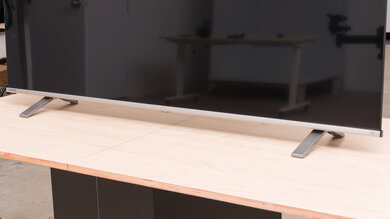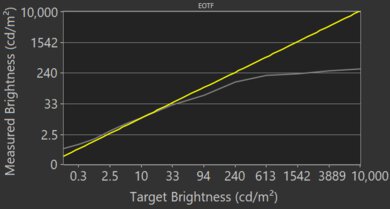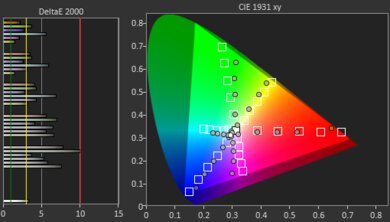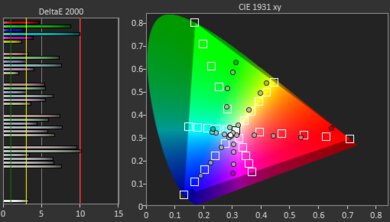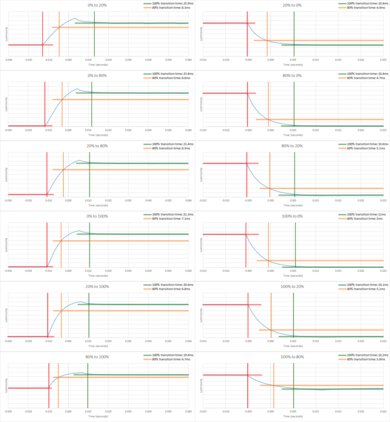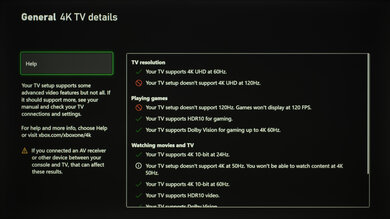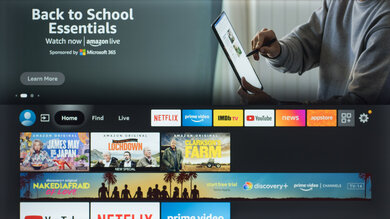The Toshiba C350 Fire TV 2021 is a basic entry-level TV that replaces the Toshiba Fire TV 2020, and it's Toshiba's only TV available in the United States. It competes with other entry-level TVs like the Hisense A6G, Vizio V5 Series 2021, and Insignia F30 Series 2022. Amazon has also released their own branded TVs, and this TV is very similar to the Amazon Fire TV 4-Series. It uses the Amazon Fire TV smart platform, which is user-friendly and has a great selection of apps available to download. It supports Apple AirPlay if you want to cast content from your phone, but not Google Chromecast. It's available in a wide range of sizes from 43 to 75 inches, so you can get the perfect size for your needs.
Our Verdict
The Toshiba C350 is a mediocre TV overall. It has a wide viewing angle, making it alright for watching shows or sports in a wide seating area. However, it has low contrast and it's disappointing for watching movies in a dark room. HDR adds almost nothing to this TV, as it can't get bright enough to bring out bright highlights in HDR and it can't display a wide color gamut. It isn't bad for gaming, but it doesn't have any extra gaming features.
- 55 inch model has wide viewing angles.
- Flicker-free backlight reduces image duplication.
- Decent response time; no black smearing on the 55 inch unit.
- Our 55 inch model has a low contrast ratio and poor black uniformity.
- Lacks a local dimming feature.
- Low peak brightness in SDR and HDR.
- Doesn't upscale lower-resolution content well.
The Toshiba C350 is disappointing for watching movies in the dark. It has low contrast, so blacks appear raised and the entire screen has a glow to it when you're in a dark room. The black uniformity is poor, and there's no local dimming feature to improve it. It also can't remove judder from any source, so movies aren't played back smoothly.
- Displays 1080p and 4k content without any issues.
- Can't remove 24p judder from any source.
- Our 55 inch model has a low contrast ratio and poor black uniformity.
- Lacks a local dimming feature.
The Toshiba C350 Series is decent for watching TV shows in a moderately-lit room. The built-in Fire TV platform has a ton of apps available to download, so you can easily stream your favorite content. It has decent reflection handling, but it's not ideal for well-lit rooms because it doesn't get very bright and glare is distracting. On the other hand, it has a wide viewing angle, which is great if you have a wide seating area, as the image remains consistent from the sides.
- 55 inch model has wide viewing angles.
- Decent reflection handling.
- Low peak brightness in SDR and HDR.
- Doesn't upscale lower-resolution content well.
The Toshiba C350 Series is okay for watching sports in bright environments. Fast-moving content looks decent due to the fairly quick response time, and there's no backlight flicker that would cause image duplication. It has a wide viewing angle, making it a decent choice for watching the game with a large group of friends as you don't have to fight over the best spot. It has decent reflection handling, but it doesn't get bright enough to fight glare.
- 55 inch model has wide viewing angles.
- Decent reflection handling.
- Flicker-free backlight reduces image duplication.
- Low peak brightness in SDR and HDR.
- Doesn't upscale lower-resolution content well.
- Dirty screen effect in the center.
The Toshiba C350 Series isn't bad for playing video games. It has a decent response time and low input lag for a responsive gaming experience. However, it doesn't have any extra gaming perks like variable refresh rate support. It has a wide viewing angle, so it's a decent choice for couch co-op games or party games with a wide seating arrangement, as the image remains consistent when viewed from the sides. Unfortunately, it's not a good choice for gaming in the dark due to its low contrast ratio.
- Low input lag in Game Mode.
- Decent response time; no black smearing on the 55 inch unit.
- Our 55 inch model has a low contrast ratio and poor black uniformity.
- Lacks a local dimming feature.
- No VRR technologies.
The Toshiba C350 TV is poor for watching HDR movies. It can't display the wide color gamut needed for HDR content, and it doesn't get bright enough to make highlights pop. It has a low contrast ratio, so dark scenes aren't displayed properly and blacks appear raised. It also lacks a local dimming feature to improve the appearance of dark scenes.
- Displays 1080p and 4k content without any issues.
- Our 55 inch model has a low contrast ratio and poor black uniformity.
- Lacks a local dimming feature.
- Low peak brightness in SDR and HDR.
- Can't display a wide color gamut.
The Toshiba C350 is okay for HDR gaming. It delivers a responsive gaming experience thanks to the low input lag, and motion handling is decent too. However, HDR content doesn't look good because it has low HDR peak brightness and can't display a wide color gamut. Our unit also has a low contrast ratio and there's no local dimming feature to improve it.
- Low input lag in Game Mode.
- Decent response time; no black smearing on the 55 inch unit.
- Our 55 inch model has a low contrast ratio and poor black uniformity.
- Low peak brightness in SDR and HDR.
- No VRR technologies.
- Can't display a wide color gamut.
The Toshiba C350 is okay for PC gaming, but it's not a good choice for desktop use as a PC monitor. It's one of the only TVs available that doesn't display chroma 4:4:4 properly at any resolution, so text looks blurry. On the other hand, it has a wide viewing angle, ensuring the sides of the screen remain consistent when you're sitting up close.
- 55 inch model has wide viewing angles.
- Decent reflection handling.
- Flicker-free backlight reduces image duplication.
- Low peak brightness in SDR and HDR.
- Dirty screen effect in the center.
- Can't display chroma 4:4:4 with any resolution.
Changelog
- Updated Nov 20, 2024: We uploaded the latest brightness measurements and uniformity photos for the Accelerated Longevity Test.
- Updated Sep 11, 2024: We uploaded the latest brightness measurements and uniformity photos for the Accelerated Longevity Test.
- Updated Jul 25, 2024: We changed 'Backlight' from 'Edge' to 'Direct' in the Local Dimming section since the backlight is direct-lit.
- Updated Jul 17, 2024: We uploaded the latest brightness measurements and uniformity photos for the Accelerated Longevity Test.
Check Price
Differences Between Sizes And Variants
We tested the 55-inch Toshiba C350 (55C350KU), and this review is also valid for the 43, 50, 65, and 75-inch models.
| Size | Model Code | Retailers |
|---|---|---|
| 43" | 43C350KU | Amazon, Best Buy |
| 50" | 50C350KU | Amazon, Best Buy |
| 55" | 55C350KU | Amazon, Best Buy |
| 65" | 65C350KU | Best Buy |
| 75" | 75C350KU | Best Buy |
Our unit of the C350 was manufactured in March 2021; you can see the label here.
Popular TV Comparisons
The Toshiba C350 is a basic entry-level TV that's disappointing even for a low-cost option. It's nearly identical to the Insignia F30 Series 2022, and it doesn't improve at all from the Toshiba Fire TV 2020 and gets worse in a few areas like brightness and upscaling. Even if you're looking for a cheap TV, better options are available with a few more features or better performance, like the newer Toshiba C350 Series 2023 or the Hisense A6G.
See our recommendations for the best budget TVs, the best smart TVs, and the best small TVs.
The Toshiba C350 Series 2023 is a solid improvement over the Toshiba C350 Series 2021. The 2021 model is flicker-free in all picture modes and all brightness levels and has better HDR gradient handling than the 2023 model. Outside of those two things, the newer model is better than its predecessor in every facet.
The Insignia F50 QLED is much better than the Toshiba C350 Series 2021. The Insignia has much better contrast, higher peak brightness, and better uniformity, meaning it's a much better choice for a dark room. On the other hand, the Toshiba has a much wider viewing angle, so it's a better choice for a wide seating arrangement.
The Amazon Fire TV 4-Series and the Toshiba C350 Series 2021 use different panel technologies, each with strengths and weaknesses. The Amazon TV has much better contrast, so it's a better choice for a dark room. The Toshiba TV has wide viewing angles, but it's not a good choice for a bright room, as it can't overcome glare.
The Hisense A6G and the Toshiba C350 Series 2021 are both okay entry-level TVs. The units we tested of each have the same panel type, but they both have variants with different panel types, too. Although picture quality isn't good on either, the Hisense does a better job at upscaling low-resolution content, like from DVDs and cable boxes, and it gets a bit brighter. The Hisense has a few more features like the ability to remove judder from 24p sources and display chroma 4:4:4, which the Toshiba can't do. The Fire TV platform on the Toshiba is easier to use than Android TV, but the Android TV is more customizable.

We buy and test dozens of TVs yearly, taking an objective, data-driven approach to deliver results you can trust. Our testing process is complex, with hundreds of individual tests that take over a week to complete. Most of our tests are done with specially designed test patterns that mimic real content, but we also use the same sources you have at home to ensure our results match the real-world experience. We use two main tools for our testing: a Colorimetry Research CR-100 colorimeter and a CR-250 spectroradiometer.
Test Results

The Toshiba C350 has a redesigned style compared to the Toshiba Fire TV 2020, as it looks sleeker. The bezels aren't as intrusive, and the bottom bezel is now silver. Even the feet are metallic instead of plastic. It doesn't seem like a cheap TV and should look nice in any setup.
After two months on the longevity test the peak brightness of this TV has dropped a bit. It's still unclear if this is just a temporary drop or if it'll continue to drop long-term.
The back of the Toshiba C350 actually looks a lot like a Hisense TV, like the Hisense H6570G. The top part holding the panel is textured metal, and the parts at the bottom and on the inputs are both plastic. Sadly, there's nothing for cable management. There are hook-like objects on the back of the legs, but they don't do anything for the cables.
The bezels aren't as obvious as on the Toshiba Fire TV 2020 and are slightly thinner.
The FireTV 2021 has decent build quality. It's designed differently than the Toshiba Fire TV 2020, but the materials used seem to be the same as it's made of both plastic and metal. It improves in a few areas like the metal feet and the thinner borders. It feels solid throughout and doesn't wobble side-to-side, but it tilts easily back to front.
The SDR brightness is bad. It's much worse than the Toshiba Fire TV 2020 and it doesn't get bright enough to fight glare in well-lit rooms. Luckily, the brightness doesn't vary at all between different scenes.
These measurements are after calibration in the 'Movie' Picture Mode with the Backlight set to its max, Contrast at '75', Mid Luminance Gamma set to '-1', and Color Temperature set to 'Warm'.
There's no local dimming feature. We still film these videos on the TV so you can see how the backlight performs and compare it with a TV that has local dimming.
Once again, there's no local dimming, and the videos above are provided so you can see how the backlight performs in Game Mode versus a TV with local dimming.
The Toshiba C350 has bad HDR brightness. It gets brighter than in SDR, but it's not enough to make highlights pop in HDR. Once again, there's no variation in brightness between scenes. The EOTF doesn't follow the target very well as darker scenes are over-brightened and bright scenes are too dark, causing a loss in details.
These measurements are in the 'Movie' HDR Picture Mode with the Backlight at its max and the Color Temperature set to 'Warm 2' and all other image processing disabled.
The HDR brightness in Game Mode looks a bit brighter than outside of Game Mode, but the results are about the same. It's not enough to make highlights stand out. These measurements are with the same settings as outside of Game Mode, but with the HDR Picture Mode set to 'Game'.
The Toshiba C350 has okay gray uniformity, but the sides of the screen are significantly darker than the center. There's also some dirty screen effect in the center, which is distracting while watching sports. Uniformity is better in near-dark scenes, but there's still some backlight bleed along the edges.
The Toshiba C350 Series has a good viewing angle. The image remains consistent as you move off to the side, with very little color shift, but it appears darker at really wide angles. This makes it a good choice for a wide seating arrangement, as anyone sitting to the side will still enjoy a consistent image.
The reflection handling is decent. It handles a small amount of light well, like from a lamp or overhead lightbulbs, but it's not as good with strong light sources on it. It's a bit worse than the Toshiba Fire TV 2020 because it reflects more light straight back.
The accuracy before calibration is very good. Most colors are only slightly inaccurate, and any issues aren't really noticeable. However, the white balance is a bit off, and the gamma doesn't follow the target well, so most scenes are too dark. Also, the color temperature is colder than the 6500K target, giving the image a blue tint.
The accuracy after calibration is excellent, but the calibration settings are limited, and you can't adjust the white balance. Still, the colors and white balance improved, and the color temperature is close to the target. Gamma is also better overall, but most scenes are still too dark.
You can see our full calibration settings here.
Sadly, the Toshiba C350 doesn't upscale 480p content properly, so it's not suggested for watching DVDs from an older source. As long as your source upscales DVDs to at least 1080p, you won't have any issues. The image looks blurry, and it doesn't display a proper 16:9 aspect ratio either. The photo above is cropped for the proper ratio and you can see the original here.
Unlike the Toshiba Fire TV 2020, the Toshiba C350 TV isn't good at displaying 720p content like from cable boxes. The image is less sharp and looks choppy.
This TV displays a perfect 4k image and there aren't any dithering issues like with the Toshiba Fire TV 2020.
Due to the narrow color gamut, the color volume is disappointing. Bright colors are displayed well, but it can't display dark saturated colors well due to its low contrast ratio.
This TV has excellent gradient handling in SDR. There's some banding in dark shades of gray and green, but it's not very noticeable. The Debanding Filter improves gradients in real content when set to 'High' or 'Medium'.
Although some IPS panels can suffer from temporary image retention, this doesn't appear to be permanent as the IPS panel in our long-term test is immune.
The Toshiba C350 has a decent response time. Although it's slower than the Toshiba Fire TV 2020, there's a lot less overshoot with darker transitions, so you won't notice any black smearing behind darker shades.
Unfortunately, there's no optional backlight strobing feature, commonly known as black frame insertion, to help improve the appearance of motion.
The Toshiba C350 Series doesn't have a motion interpolation feature.
Due to the somewhat slower response time, there's not much stutter with lower-frame rate content.
Sadly, the Toshiba C350 TV doesn't remove judder from any source. This is disappointing considering most entry-level TVs like the LG UP7000 can at least remove judder from native 24p sources.
The Toshiba C350 has a basic 60Hz panel and doesn't support any variable refresh rate technologies.
The Toshiba 55C350KU has very low input lag as long as you're in Game Mode. There's very little delay between your actions on your controller and the action on screen.
The Toshiba C350 only displays basic signals at 60Hz, and it can't display chroma 4:4:4 properly at any supported resolution. This is disappointing if you want to use it as a PC monitor, as most text appears blurry.
As the TV doesn't support high-frame rate content, you're limited to 4k gaming at 60Hz from either the Xbox Series X or PS5. It has an Auto Low Latency Mode setting that automatically switches the TV into Game Mode when you play a game from a compatible device, but it's not clear that it's in Game Mode. A HDR symbol appears in the top right, as you can see in this photo.
The Toshiba C350 TV is one of the few TVs we've tested in 2021 that still has Composite inputs, which is great if you have old entertainment devices, like DVD players or a PS2.
The Toshiba C350 Series has eARC support, allowing you to pass high-quality, uncompressed audio like Dolby Atmos or DTS:X formats to a compatible receiver through an HDMI connection.
The Toshiba C350 has a poor frequency response. It doesn't produce any low bass, so there's no thump or rumble in action scenes. It doesn't get very loud, and the sound profile isn't the most balanced either, but it's fine enough to listen to dialogue.
The Toshiba C350 has great distortion performance. There isn't much distortion even when listening at its max volume, and not everyone may hear it.
The Toshiba C350 comes with the Amazon Fire TV platform built-in. It's user-friendly, and the menu navigation feels smooth with no obvious bugs. It's not as advanced as some other platforms, but it's still good for most people.
The app store has a great selection of apps available to download. You can cast content from your phone, but it's not as easy as other TVs. It doesn't support Google Chromecast, so you have to screen mirror your Android phone, but it does have Apple AirPlay and HomeKit, so it's more user-friendly for iOS users.
The Toshiba C350 comes with the same remote as the Toshiba Fire TV 2020. It's simple with the necessary navigation buttons and shortcut buttons to popular streaming services. The built-in mic allows you to ask to change HDMI inputs, open apps, and search for content, but you can't ask it to change certain settings. It also works with compatible Amazon Alexa devices.



